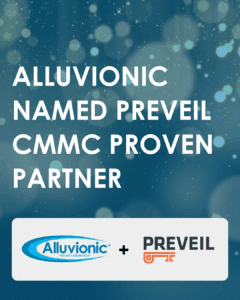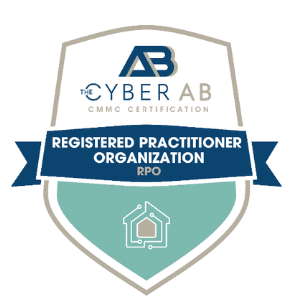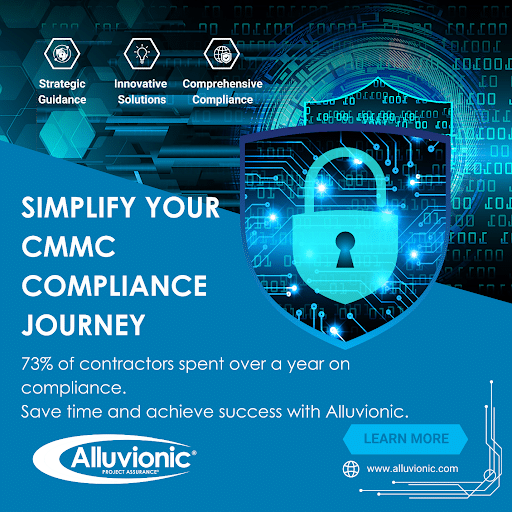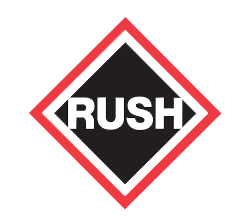
Alluvionic Named PreVeil CMMC Proven Partner, One of Five Recognized to Date
Alluvionic Named PreVeil CMMC Proven Partner Alluvionic has been selected as a PreVeil CMMC Proven Partner, a designation awarded to partners who either received a
CMMC is here! Register for our free webinar with guests from C3PAOs – Nov 18 @ 1PM EST. Save Your Spot →
Home » Cybersecurity Compliance » CMMC Compliance » CMMC Compliance Guide
Alluvionic’s End-to-End Support
For defense contractors, CMMC compliance is no longer optional—it’s a requirement for winning and retaining DoD contracts. However, navigating the process can be complex, especially for small to mid-sized businesses that may not have dedicated cybersecurity teams. Without a structured approach, companies risk compliance failures, costly delays, and contract loss.
At Alluvionic, we simplify CMMC compliance. Our four-phase approach—Gap Analysis, Remediation, Assessment Preparation, and Certification Support—ensures you meet all necessary security requirements while minimizing disruptions to your business.

Why a Gap Analysis is the First Step to CMMC Success
Achieving CMMC compliance can feel overwhelming, especially for small to mid-sized government contractors who may not have dedicated cybersecurity teams. The first and most critical step in the compliance journey is a Gap Analysis—an in-depth assessment that identifies where your current security practices align with CMMC requirements and where you need improvements.
At Alluvionic, our Gap Analysis process is designed to take the guesswork out of compliance. We help you understand exactly what needs to be done, how to prioritize your security upgrades, and what steps you need to take to achieve and maintain compliance efficiently.
What is a Gap Analysis?
A Gap Analysis is a detailed evaluation of your current cybersecurity posture compared to CMMC requirements. It identifies:
Our proven methodology follows a structured approach to identify, analyze, and remediate compliance gaps—minimizing risk and ensuring a smooth certification process.
Step 1: Understanding Your Business & Contract Requirements
Before diving into the technical security review, we start by understanding:
Why This Matters: Many businesses incorrectly assume they need to secure every part of their network when only certain systems handling FCI or CUI fall under CMMC scope. By defining scope early, we can reduce compliance costs and streamline certification efforts.
Step 2: Identifying and Mapping Your CUI & FCI Data Flow
One of the biggest challenges in CMMC compliance is knowing where sensitive data resides and how it moves through your organization.
We conduct a Data Flow & Asset Mapping Exercise to:
Why This Matters: If CUI is exposed in an unprotected system, you cannot pass Level 2 certification. By isolating CUI-related systems, we can minimize your compliance burden.
Step 3: Technical & Policy Review Against CMMC Requirements
Once we understand your environment and data flow, we evaluate your security controls against CMMC requirements—focusing on 110 controls for Level 2 (based on NIST SP 800-171 rev2) or the 15 basic practices for Level 1.
Why This Matters: Many companies believe they are compliant because they have strong cybersecurity protections—but if they lack proper documentation, they will fail an assessment.
Step 4: Gap Report & Prioritized Remediation Plan
After conducting our in-depth review, we provide a detailed report outlining:
Why This Matters: Many contractors overcomplicate their compliance strategy, spending time and money on unnecessary security upgrades. Our prioritized roadmap ensures you only focus on what’s required.

What is CMMC Remediation?
Remediation is the most intensive phase of the CMMC compliance journey, often requiring 9 to 12 months of focused effort. This phase involves:
Without proper remediation, businesses risk failing their CMMC certification assessment—leading to delays, extra costs, and potential contract loss. At Alluvionic, we guide you through every step of remediation, ensuring your security upgrades are effective, well-documented, and assessment-ready.
Why Does Remediation Take 9-12 Months?
Many companies underestimate the remediation phase, assuming it’s just about fixing IT issues. In reality, compliance is a business-wide effort requiring:
Pro Tip: Companies that try to rush remediation often fail assessments due to missing documentation or untested security controls. Proper planning and execution are key.
How Alluvionic Streamlines CMMC Remediation
Our structured remediation process ensures you close security gaps efficiently while minimizing disruptions to business operations. We focus on three key areas:
Pro Tip: Remediation demands a clear strategy, a disciplined project plan, and expert project management. At Alluvionic, we take the lead—driving the process to keep everything on track, on schedule, and on budget.
Technical Security Fixes – Strengthening Your IT Infrastructure
CMMC compliance requires a robust cybersecurity foundation. We work closely with your IT team or Managed Service Provider (MSP) to:
Pro Tip: We often segregate CUI systems from general IT infrastructure, reducing compliance costs and complexity by limiting the number of systems subject to CMMC requirements.
Even if you implement every security control, you can still fail an assessment if you don’t have the proper documentation. Assessors require proof that:
Pro Tip: Many companies use third-party IT services (Managed Service Providers – MSPs). We ensure that your MSP’s security measures align with CMMC and that you have documentation proving compliance.
Over 80% of data breaches involve human error. Even with strong security controls, a single mistake—such as an employee clicking a phishing link—can jeopardize compliance.
Executives & Leadership – Understanding compliance requirements and risk management.
IT & Security Teams – Implementing and managing CMMC security controls.
General Employees – Recognizing phishing attacks, social engineering threats, and safe CUI handling.
Pro Tip: Employees are your biggest security risk AND your best defense. Continuous training helps create a culture of security awareness.
What is Assessment Preparation?
Preparing for a CMMC assessment (or self-assessment) requires more than just fixing gaps—it means ensuring:
How Alluvionic Ensures You’re Prepared
We perform full-scale test assessments, simulating a C3PAO or DoD assessment. This helps:
We verify that:
Your employees must demonstrate awareness of cybersecurity policies and best practices. We ensure they:
Pro Tip: A well-trained team improves your assessment performance, increasing your chances of first-time certification success.
What is Certification Prep?
For companies requiring a C3PAO assessment (CMMC Level 2 high-priority CUI), we provide full support through the certification process, ensuring a smooth, stress-free experience.
How Alluvionic Supports Your Certification
Why This Matters: CMMC certification isn’t just about passing a single assessment—it’s about long-term security and DoD contract eligibility. We help you maintain compliance beyond certification.
Let’s talk about how Alluvionic can support your goals.

Alluvionic Named PreVeil CMMC Proven Partner Alluvionic has been selected as a PreVeil CMMC Proven Partner, a designation awarded to partners who either received a

Alluvionic, featured in Unanet’s Guide to CMMC, showcases how strong project assurance and cybersecurity expertise drive compliance and readiness success.

The Cybersecurity Maturity Model Certification (CMMC) 2.0 Final Rule is here, and contractors across the defense industrial base (DIB) are preparing for what comes next.







Whether you need project management, process improvement, cybersecurity, product development, training, or government services, Alluvionic has the expertise to provide Peace of Mind and Project Assurance®.